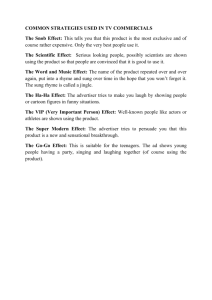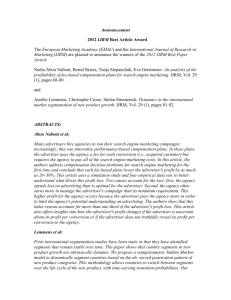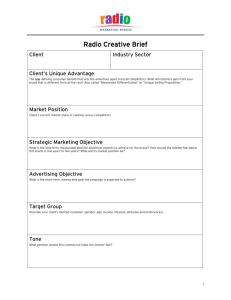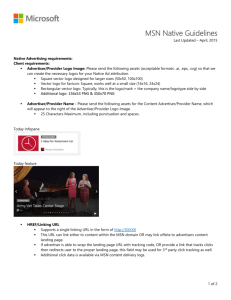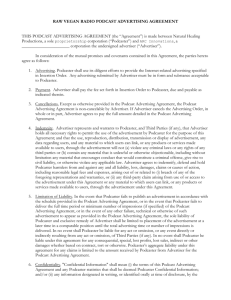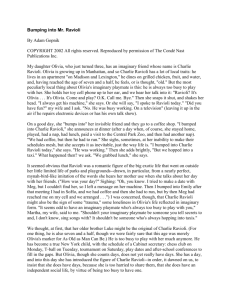Responding to a Visual Argument
advertisement
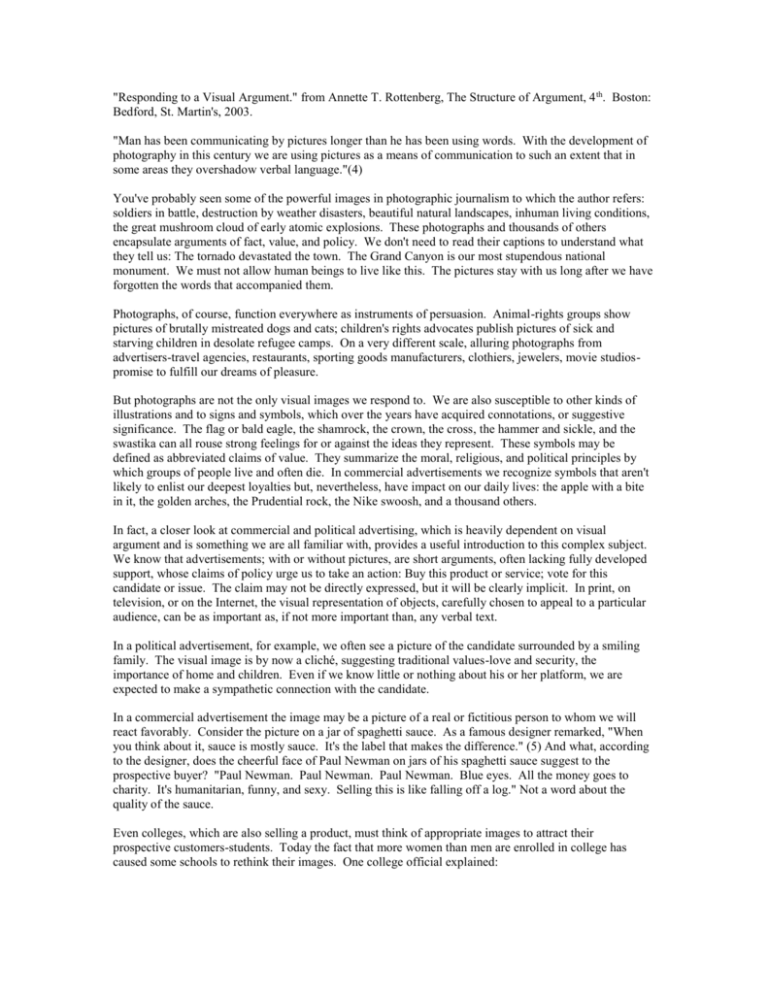
"Responding to a Visual Argument." from Annette T. Rottenberg, The Structure of Argument, 4 th. Boston: Bedford, St. Martin's, 2003. "Man has been communicating by pictures longer than he has been using words. With the development of photography in this century we are using pictures as a means of communication to such an extent that in some areas they overshadow verbal language."(4) You've probably seen some of the powerful images in photographic journalism to which the author refers: soldiers in battle, destruction by weather disasters, beautiful natural landscapes, inhuman living conditions, the great mushroom cloud of early atomic explosions. These photographs and thousands of others encapsulate arguments of fact, value, and policy. We don't need to read their captions to understand what they tell us: The tornado devastated the town. The Grand Canyon is our most stupendous national monument. We must not allow human beings to live like this. The pictures stay with us long after we have forgotten the words that accompanied them. Photographs, of course, function everywhere as instruments of persuasion. Animal-rights groups show pictures of brutally mistreated dogs and cats; children's rights advocates publish pictures of sick and starving children in desolate refugee camps. On a very different scale, alluring photographs from advertisers-travel agencies, restaurants, sporting goods manufacturers, clothiers, jewelers, movie studiospromise to fulfill our dreams of pleasure. But photographs are not the only visual images we respond to. We are also susceptible to other kinds of illustrations and to signs and symbols, which over the years have acquired connotations, or suggestive significance. The flag or bald eagle, the shamrock, the crown, the cross, the hammer and sickle, and the swastika can all rouse strong feelings for or against the ideas they represent. These symbols may be defined as abbreviated claims of value. They summarize the moral, religious, and political principles by which groups of people live and often die. In commercial advertisements we recognize symbols that aren't likely to enlist our deepest loyalties but, nevertheless, have impact on our daily lives: the apple with a bite in it, the golden arches, the Prudential rock, the Nike swoosh, and a thousand others. In fact, a closer look at commercial and political advertising, which is heavily dependent on visual argument and is something we are all familiar with, provides a useful introduction to this complex subject. We know that advertisements; with or without pictures, are short arguments, often lacking fully developed support, whose claims of policy urge us to take an action: Buy this product or service; vote for this candidate or issue. The claim may not be directly expressed, but it will be clearly implicit. In print, on television, or on the Internet, the visual representation of objects, carefully chosen to appeal to a particular audience, can be as important as, if not more important than, any verbal text. In a political advertisement, for example, we often see a picture of the candidate surrounded by a smiling family. The visual image is by now a cliché, suggesting traditional values-love and security, the importance of home and children. Even if we know little or nothing about his or her platform, we are expected to make a sympathetic connection with the candidate. In a commercial advertisement the image may be a picture of a real or fictitious person to whom we will react favorably. Consider the picture on a jar of spaghetti sauce. As a famous designer remarked, "When you think about it, sauce is mostly sauce. It's the label that makes the difference." (5) And what, according to the designer, does the cheerful face of Paul Newman on jars of his spaghetti sauce suggest to the prospective buyer? "Paul Newman. Paul Newman. Paul Newman. Blue eyes. All the money goes to charity. It's humanitarian, funny, and sexy. Selling this is like falling off a log." Not a word about the quality of the sauce. Even colleges, which are also selling a product, must think of appropriate images to attract their prospective customers-students. Today the fact that more women than men are enrolled in college has caused some schools to rethink their images. One college official explained: We're having our recruiting literature redesigned, and we've been thinking about what's a feminine look and what's a masculine look. We have a picture of a library with a lot of stained glass, and people said that was kind of a feminine cover. Now we're using a picture of the quadrangle." (6) In addition to the emblem itself, the designer pays careful attention to a number of other elements in the ad: colors, light and shadow ' foreground and background, relative sizes of pictures and text, and placement of objects on the page or screen. Each of these contributes to the total effect, although we may be unaware of how the effect has been achieved. (In the ad that follows, you will be able to examine some of the psychological and aesthetic devices at work.) When there is no verbal text, visual images are less subject to analysis and interpretation. For one thing, if we are familiar with the objects in the picture, we see the whole image at once, and it registers immediately. The verbal message is linear and takes far longer to be absorbed. Pictures, therefore, appear to need less translation. Advertisers and other arguers depend on this characteristic to provide quick and friendly acceptance of their claims, although the image may, in fact, be deceptive. This expectation of easy understanding poses a danger with another visual ally of the arguer-the graph or chart. Graphics give us factual information at a glance. In addition to the relative ease with which they can be read, they are 'at their best ... instruments for reasoning about quantitative information.... Of all methods for analyzing and communicating statistical information, well-designed data graphics are usually the simplest and at the same time the most powerful." (7) Nevertheless, they may mislead the quick reader. Graphics can lie. "The lies are told about the major issues of public policy-the government budget, medical care, prices, and fuel economy standards, for example. The lies are systematic and quite predictable, nearly always exaggerating the rate of recent change." (8) Visual images, then, for all their apparent immediacy and directness, need to be read with at least the same attention we give to the verbal message if we are to understand the arguments they represent. We have pointed out that a commercial advertisement is a short argument that makes an obvious policy claim, which may or may not be explicit: You should buy this product. Depending on the mediumtelevision, print, radio, or Internet-an ad may convey its message through language, picture, or sound. Here is how one analyst of advertising sums up the goals of the advertiser: 1) attract attention, 2) arouse interest, 3) stimulate desire, 4) create conviction, and 5) get action. (9) Needless to say, not every ad successfully fulfills all these objectives. If you examine the ad reproduced here, you can see how the advertiser brings language and visual image together in an attempt to support the claim. . (Advertisement not included here.) First of all, you must imagine the principal objects of the ad in color-white bread on one side, red ravioli on the other. Of course, the advertiser, Chef Boyardee, expects the reader to find the ravioli more attractive. Like most pictures of food, these are designed to attract attention and arouse interest. Whether they stimulate desire depends on a number of things that the advertiser cannot control who the reader is, how much the reader likes such food, how hungry he or she is at the time of the reading, and so on. Notice the word simple, which is printed in bright red in the headline. This word emphasizes both the visual image (the clear, uncluttered arrangement of the pictures, lots of white space, the neat lineup of the comparative data) and the content message as well (that is, that the claim is unambiguous and uncontroversial). Simplicity is not always a positive attribute, but to advertisers the word simple is a magic wand that dispels the buyer's fear of whatever might be complicated or obscure. You may not be immediately aware that the word simple makes a connection with the word goodness, also in bright red, in the lower right corner. One analyst points to this arrangement as "an extremely important dimension" because "when we read, the eye moves from the upper left corner of the page to the lower right corner."(10) The ravioli, too, appear on the preferred side, the right, where the eye will pause or encounter the end of the message. It is the emphatic position Support for the claim that Chef Boyardee Beef Ravioli should be your choice appears in the data under the pictures. The data here are limited to numbers, as the headline predicts: "An after-school lesson in simple mathematics." Again, even the visual arrangement of the numbers suggests openness and clarity. The numbers themselves are meant to create conviction. The advertiser, however, omits any authority for them, and critics have noted that such numbers on containers are sometimes inaccurate. Not surprisingly, the advertiser concentrates on fat content because in this respect, perhaps only in this respect, is the ravioli superior. (Arguers about social issues also engage in this strategy of calculated omission.) Additional support appears in the paragraph below. Here, too, the spacing is open, generous, and easy to read, and we learn about other healthful qualities of the beef ravioli. The advertiser seems to allege that its product is distinctive in regard to these good things. But, in fact, they are true for almost all pasta and meat sold in the United States, and all preservatives, contrary to the advertiser's implication, are not harmful. Other producers have made equally ambiguous claims. Schlitz Beer boasted in its ads that its bottles were steam-sterilized, without revealing that bottles of all other beer companies were also steam-sterilized. (11) The warrant that underlies the claim becomes clear in the last one-sentence paragraph. We've been aware all along that the appeal is not to children, the chief consumers of peanut butter and jelly sandwiches. The phrase "your kids" tells us that the appeal is directed to parents. We now understand the unexpressed warrant: Parents can be counted on to provide what is most healthful for their children. It's worth noting, too, that the paragraph of text probably doesn't play a significant role in the argument. The emphasis rests on the picture and the chart, and the advertiser counts on them to make an impression that will persuade the reader to buy its product even if he or she doesn't read the text. Their place in the upper half of the ad is like a headline and the first paragraph of a news story, which is all that many people read. Is the ad successful in getting action? The advertiser has tried to establish itself, in both the visual and the verbal content of its message, as a friend of the reader, open, truthful, committed to the health of children. It has assumed that the fat content of food is of high importance to the parents who read the ad. And perhaps it is, but despite the apparent validity of the warrant, the success of the ad is unpredictable. The plump red ravioli may appeal to the parent, but many children will prefer the sandwich, and for reasons that advertisers can't control, the parent may choose what the children want. Advertisers who show pictures of expensive toys on children's television programs have already learned this lesson. 4 Paul Wendt, "The Language of Pictures," in S. 1. Hayakawa, ed., The Use and Misuse of language (Greenwich, Conn.: Fawcett, 1962), p. 175. 5 Tibor Kalman, "Message: Sweet-Talking Spaghetti Sauce," New York Times Magazine, December 13, 1998, p. 81. 6 New York Times, December 6, 1998, p. 38. 7 Edward R. Tufte, The Visual Display of Quantitative Information (Cheshire, Conn.: Graphics Press, 1983), introduction. 8 Tufte, The Visual Display, p. 76. 9. V. Lund, Newspaper Advertising (New York: Prentice-Hall, 1947), p. 83. 10 Torben Vestergaard and Kim Schroder, The Language of advertising (Oxford: Oxford University Press, 1986), p. 44. 11 Daniel J. Boorstin, The Image; or, What Happened to the American Dream? (New York: Atheneum, 1962), p. 214. QUESTIONS FOR ANALYSIS-Visual Rhetoric 1 .What does the arguer want me to do or believe? How important is the visual image in persuading me to comply? 2.Has the visual image been accompanied by sufficient text to answer questions I may have about the claim? 3.Are the visual elements more prominent than the text? If so, why? 4.Is the visual image representative of a large group, or is it an exception that cannot support the claim? 5.Does the arrangement of elements in the message tell me what the arguer considers most important? If so, what is the significance of this choice? 6.Can the validity of this chart or graph be verified? 7.Does the visual image lead me to entertain unrealistic expectations? (Can using this shampoo make hair look like that shining cascade on the television screen? Does the picture of the candidate for governor, shown answering questions in a classroom of eager, smiling youngsters, mean that he has a viable plan for educational reform?)
